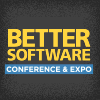Better Software Conference & EXPO 2008

PRESENTATIONS
|
Flow, Pull, Innovate: The Secrets to Agile Adoption
Jean Tabaka provides straightforward guidance on how teams can begin their agile journey and learn to mature and scale into more and more discipline. The five-step approach emphasizes a path based on the principles of Lean Thinking-Flow, Pull, and Innovate. Each of the five steps outlines specific practices for growth as well as pitfalls and roadblocks to navigate and avoid. Step 1: The team learns to work in a continuous flow. Step 2: The team matures by pulling ready items from the backlog. |
|
|
Function Point Analysis: A Quick and Easy Primer
The function point metric is used by many organizations worldwide to more accurately size systems. Knowing the size of a system allows developers to better meet customer demands of functionality within time and budget and communicate about these issues with the system "owners." Based on the latest version of the International Function Point Users Group (IFPUG) Counting Practices Manual, David Garmus and David Herron provide a detailed explanation of the rules engineers must follow to accurately count function points. |
|
|
Fuzzing: New Tests for Robustness and Security
Traditional security measures are doomed to fail because they are focused only on defending against known attacks-and studies show that more than 80 percent of software will likely crash when extensive negative testing is employed. Fuzzing is a new, proactive technique for discovering security vulnerabilities and robustness issues in software. Although fuzz testing is most often based on some form of syntax checking, random input testing also can be appropriate. |
|
|
Lessons Learned in Programmer Testing
It has been more than six years since the first release of NUnit 2.0, an open source unit testing tool. In that time, literally millions of tests have been written using the tool. Many of these tests have become and continue to be invaluable resources for their teams. Unfortunately, many other NUnit-based tests have not been maintained and are now viewed as having been a waste of effort from the beginning. What separates tests that are used, maintained, and highly valued from tests that are quickly discarded? |
|
|
Lessons Learned in Project Management
You've managed projects, but they're never easy. They don't fit into the nice definitions found in project management books. Your schedules are generally off. There are always unkind surprises. Although you're not failing, you feel you could be more successful. There is a solution. Based on her many years of consulting with large and small software teams, Johanna Rothman coaches leaders to take a more pragmatic approach. Employ mini-projects and iterations to explore alternative technologies. |

Johanna Rothman, Rothman Consulting Group, Inc. |
|
Maximizing ROI on New Technology Acquisition
IT departments and software technologists must invariably navigate many challenges when planning to acquire new tools, invest in new technology, fund new technology projects, and introduce process changes. How do you get the most out of these investments without upsetting existing mission-critical processes or projects? Subsequently, how do you rapidly turn your new technology into a successful release that augments your product suite? |
|
|
More than the Process Police: CMMI® Process and Product Quality Assurance
For organizations to succeed in process improvement efforts, they must determine whether newly introduced processes are, in fact, being adopted by managers and practitioners. The Capability Maturity Model Integrated (CMMI®) identifies this verification activity as Process and Product Quality Assurance (PPQA). If you think PPQA is simply "process police," you're not getting all that you should out of your CMMI® practices. Done right, PPQA can be a driving agent for change in your organization. |
|
|
Real Software QA
With the ever-increasing demand for software products, it is imperative for organizations to move away from trying to "test in" software quality and move toward adopting a comprehensive, total-life cycle software quality management approach. Such an approach is the basis of real software quality assurance (QA)-all the planned and systematic actions necessary to provide confidence that a system will perform satisfactorily in production. |

Linda Westfall, The Westfall Team |
|
Scenario-Based Software Architecture Reviews: A Quality Process
Quality attributes--performance, scalability, availability, maintainability, etc.-are often referred to as the non-functional requirements. Unfortunately, these critical factors often are specified through vague platitudes rather than explicit statements. Participatory, scenario-based architecture reviews are essential to determine if the architecture meets the system's quality attributes as well as the functional requirements. |
|
|
SOA Testing Challenges and Proven Practices
The best thing about Service Oriented Architecture (SOA) is its flexibility-a heterogeneous computing environment in which different services and service providers can use different technologies; loose coupling of components to allow any application to make use of service capabilities; and ad-hoc integration of applications within and across organizations. However, from a tester's perspective, these very advantages make the testing of Web services and SOA-based applications highly complex. |
|


